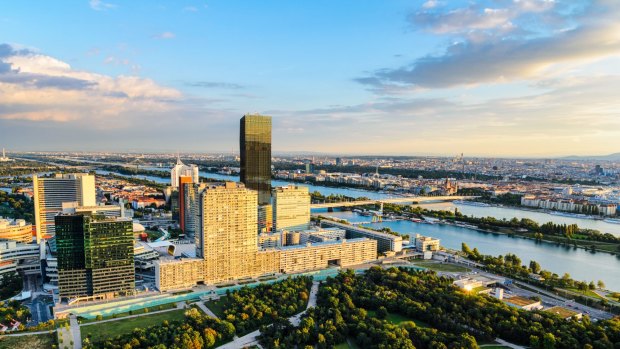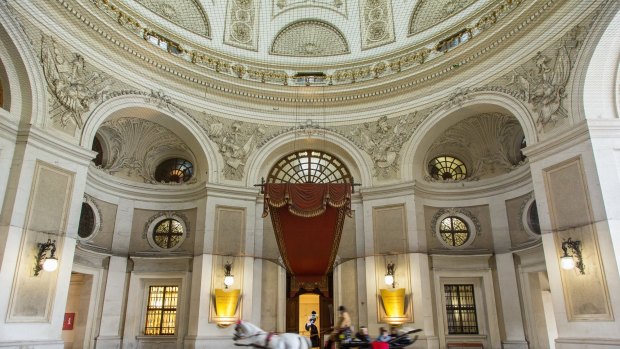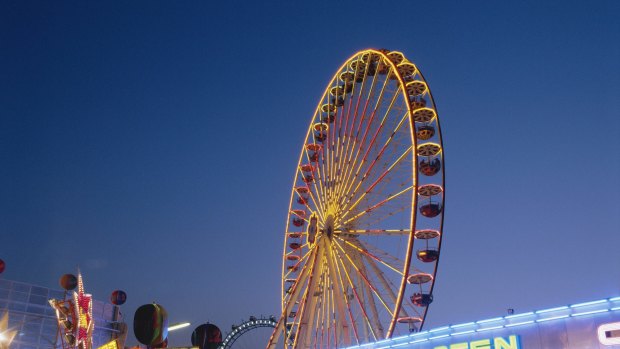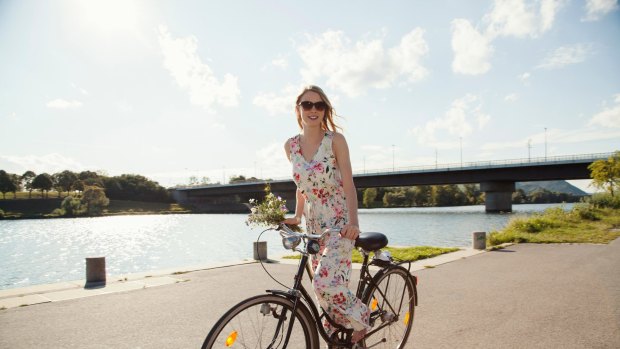This was published 9 years ago
Cycling in Vienna, Austria: The best way to see the world's most liveable city
By Kerry van der Jagt

Vienna has been named the world's most liveable city for 2015.Credit: Alamy
It doesn't take long for me to learn what all good Austrian girls know by instinct – it pays to wear tight underpants. "Tuck your skirt into your knickers and start peddling," says Gabriela Steiner, our ever-practical tour guide.
It's late afternoon and Steiner is giving me the low-down on how to ride a bike Viennese-style. "Bikes are a part of our city lifestyle," she says. "We ride in high heels, to the office or the opera, so we rarely bother with fancy bike clothes."
A last-minute decision to join a bicycle tour had left me with no time for a costume change, but Steiner's timely tip (and my sturdy briefs) soon has me sorted. We've gathered near the Museum of Applied Arts (MAK) to start our cycling lap of Vienna's Ringstrasse, the tree-lined boulevard that circles the city like a charm bracelet.
Opened on May 1 1865 by Emperor Franz Joseph the ring was built on top of the original 16th-century city walls. After declaring, "It is my will," the emperor ordered that the wall be demolished, the adjoining land sold and a series of magnificent public buildings constructed with the profits. 2015 marks the boulevard's 150th anniversary, a milestone the city is celebrating with a year-long party.
With my skirt suitably tucked and tamed we head off in a clockwise direction towards Stadtpark, a green space straddling the Vienna River. Awash in a sea of flowers the park is a remnant of the original glacis, or open slope, which formed part of the medieval fortress. Today the park is a quiet space of ponds and meadows dotted with monuments to writers, musicians and composers. The hero of the park is a gilded bronze statue of Johann Strauss II. "He was the rock star of his time," says Steiner, showing the same pride all Austrians share for their musical maestros.
From Stadtpark we follow the Ringstrasse to the Vienna State Opera, an easy ride along dedicated cycle ways. Flat Vienna is a cyclist's dream, with some 1200 kilometres of bike paths and 120 public bike rental stations (the first hour is free). "I would never bother owning a car in the city," says Steiner, "though I do have six bikes." When I question this extravagance Steiner explains that she keeps bikes at her own place, at her parents, her in-laws and a mountain chalet.

Move over Paris, London and Berlin: Vienna is on a roll.
Steiner, an architect by training, is typical of her generation: university educated, environmentally aware and conscious about health and fitness. "Bikes are also a status symbol," she admits. "Look around and you'll see that most bikes are upmarket, fixed gear models, costing thousands."
Given this enviable lifestyle it's no wonder Vienna has been ranked the world's Most Liveable City for 2015. The Quality of Living Survey, which was conducted by the international consulting firm Mercer, compares the political, social and economic climate, medical care, education, infrastructure and environmental conditions of 230 destinations. For the sixth year in a row Vienna has come out on top.
Elegant for its entire 5.3-kilometre length the boulevard is adorned with some of Vienna's most spectacular buildings including the Renaissance-style University of Vienna, the Flemish-Gothic City Hall, the neo-Gothic Rathaus and the neo-Baroque Burgtheater. "At the time of construction architectural styles were chosen to represent the building's intended purpose," she explains. Through her well-trained eye, what at first seems an eclectic mismatch becomes a graceful blend of style and substance.

Big wheel: Prater park in Leopoldstadt is Vienna's permanent – if slightly gaudy – fairground.Credit: LatitudeStock - TTL
Though Steiner provides detail about the State Opera – one of the first buildings on the Ringstrasse, opened in 1869, neo-Renaissance style – it is through her casual chats that the city's facade begins to peel back. I learn that the State Opera has performances 300 nights a year, with never the same performance on two consecutive nights. That in April, May, June and September more than 150 opera and ballet performances are beamed live to a big screen outside the opera house – for free. And that standing room tickets go on sale, for a few euros, 80 minutes before each show. "Once inside tie your scarf around the railing to claim your spot," says Steiner.
From the Opera House we detour inside the Ring (Innere Stadt), the oldest part of the city and a UNESCO World Heritage Site. Here we pass the Albertina, home to the greatest collection of graphic art in the world, the wedding-cake palaces of the Habsburg empire and the Spanish Riding School, where, for 450 years, Lipizzaner stallions have performed their timeless waltz.
From the Spanish Riding School we cycle past fountains, along cobblestones and under arches emerging at the Heldenplatz (Heroes' Square), where Adolf Hitler made his 1938 annexation speech. Pushing on we pass yellow trams and horse-drawn carriages (fiakers), the clanging of bells and clopping of hooves a delightful addition to a city already pulsing with sound and colour. The previous day I'd taken a fiaker ride along a section of the Ringstrasse and through the Old City, the pair of white horses gleaming platinum in the late afternoon sun as I reclined inside the hooded carriage, lost in a daydream of Crown princes and imperial palaces.

Tuck in: Bicycles are a practical part of the Viennese lifestyle. Credit: Alamy
This is my first trip to Vienna and for once all the books, movies and paintings have measured up to the reality: trees in a thousand shades of green, their branches linking arms across sweeping avenues. Ancient dwellings in taupe, peach and vanilla laced together with cast-iron balconies. The elegant curves of the Danube River, more biscuit-coloured than blue. Even the sausage stands look elegant.
"After a night at the opera it's customary to queue for a midnight snack of wurst, bread and beer," says Steiner. "Even if you're wearing a ball gown or a tuxedo."
From the outset the Ringstrasse was the city's most fashionable promenade, a place to ramble and relax, a continuation of the former practice of strolling along the city walls. In his family memoir, The Hare with Amber Eyes: A Hidden Inheritance, Edmund de Waal describes the newly completed Ringstrasse. "This new street is not dominated by any one building; there is no crescendo towards a palace or a cathedral; but there is this constant triumphant pull along from one great aspect of civilised life to another."
But the Ringstrasse is more than a gilded showpiece for architectural historicism, it is also a place where the icy fingers of history tug from every corner. During the construction of the Ringstrasse many prominent Jewish families built their homes here, adding to the city's economic boom and acting as collectors and patrons of the arts. But after German-Nazi occupation in 1938 Jewish people were arrested, had property confiscated and were deported in their thousands to concentration camps. Reminders of this horrific period can be found all across the city, but the most chilling is the Nameless Library in the Judenplatz, a stark memorial to the 65,000 Austrian Jews killed during the Holocaust. The bunker-shaped monument by British sculptor Rachel Whiteread is an inverted library set in concrete, where the books' spines face inwards representing the untold stories of the Holocaust victims. The names of the concentration camps are written across its base.
While the Nazis systematically destroyed more than 60 synagogues, it is reputed that they kept many of the artefacts with the view of creating a "display of extinguished cultures". Thankfully, many of these prized objects have been rediscovered and are now on display at the Jewish Museum Vienna. One of the most surprising exhibits is a bicycle owned by Theodor Herzl, the Austro-Hungarian founder of Zionism, who loved nothing more than riding around the Austrian countryside. Herzl was once quoted as saying, "A bicycle gives a person new life." Other exhibits include a collection of "anti-Semitic" artefacts, each one turned away and fronting a mirror, forcing the viewer to see his own reflection.
From the Volksgarten we pedal past the Vienna City Hall, with its gothic tower and sprawling Rathauspark. Today's tranquil scene is a marked contrast to the previous evening, when, by chance, I found myself caught up in the street parade leading to the Life Ball. An exploding piñata of rhinestone briefs and rippling flesh, the annual ball is the world's biggest AIDS/HIV benefit, a costume bash raising funds for AIDs organisations. In 2015 the motto is "Gold – Ver Sacrum", inspired by Gustav Klimt's golden paintings and Igor Stravinsky's ballet music Le Sacre du Printemps (The Rite of Spring).
Held each May the opulent opening ceremony is open to the public, attracting more than 40,000 spectators, while the Life Ball itself requires pre-purchased tickets. Steiner explains that there are two categories, regular tickets for €160 and half-price "style tickets", awarded to those who turn up in the most creative costume. "While the event is about fighting AIDS it's also about celebrating life," says Steiner.
May will see another celebration – the final of the 60th Eurovision Song Contest, the campest, most tongue-in-cheek musical event of the year. After Austrian-born Conchita Wurst won the title last year in Copenhagen, Vienna was handed the baton to host the event in 2015. What began as a means of reuniting a fractured continent after WWII now stands as a reflection of Europe's progressive liberalism, mirroring social trends and promoting inclusiveness. So inclusive they'll even let an Aussie in.
For the first time in the event's history, as part of the 60-year-celebration, Australia has been invited to compete as a wild card entry. I'm not sure if the organisers know what they are in for, but on May 23 180 million people will tune in to watch Guy Sebastian take on the best (and worst) of Europe. While some may view the event as a momentary lapse in Vienna's naturally good taste, others see it as a chance for the city to show off its relaxed, inventive side.
We see more of this laid back attitude in Leopoldstadt (district 2), a bohemian area separated from the Innere Stadt by the Vienna Canal. What was once a walled Jewish ghetto is now a vibrant community bustling with trendy cafes, galleries and bars and home to the Prater, Vienna's permanent (if slightly gaudy) fairground. Central to the park is the Wiener Riesenrad, the giant Ferris wheel built in 1897, which is just as much a symbol of the city as its music, museums and monumental palaces.
It's this blend of classic and quirky I learn to admire most about Vienna. I don't find it inside the galleries and museums but on the street; in the chandelier-lit coffee houses, in the wedges of Sacher torte, in the sausage stands and in the urban art spaces. I also find it at the beach.
Following the Danube Canal we peddle along the "Adriatic Coast", Vienna's version of a beach strip. Here (during the summer months) rows of container boats decked with swimming pools, bars and restaurants line the canal. We pass Tel Aviv beach, with its deck chairs on the sand; Badeschiff, with its bathing ship; and Sand in the City, Vienna's biggest beach club. "Everyone from old brats and young bikini bodies flock here," says Steiner. "No one minds what you wear or how you look." Though I haven't brought swimmers, for the briefest of moments I wonder if my sturdy underwear might save the day for a second time.
FIVE OTHER CITIES THAT ARE RIDING HIGH
1. New Orleans, USA – A decade after the devastation of Hurricane Katrina, the Big Easy is back – bigger and better than ever. Fresh restaurants, new bars, even a purpose built Musicians' Village, a neighbourhood built to rehouse performers who lost their homes.
2. Rotterdam, the Netherlands –with booming arts, food and cultural scenes, a revitalised "Zoho" area and regeneration of some of its grungier areas this portside city is no longer content to play second fiddle to Amsterdam.
3. Budapest, Hungary – the darling of river-cruise ships Budapest is shining brighter than ever with its contemporary art scene, fashion shows, Michelin-stared restaurants, trendy 'ruin pubs' and new hotel openings.
4. Johannesburg, South Africa – the second largest city in Africa is brushing off its crime-ridden past and reinventing itself through trendy new hotspots, new restaurants, museums, boutiques and galleries.
5. Seoul, South Korea – what was once a purely 'functional' city has morphed into a dynamic, high-tech, design-savvy city with top museums, an influential arts scene and cutting-edge architecture.
Five exhibitions in 2015
1. Ring – the Jewish story of a boulevard. From March 25 to October 4 the Jewish Museum Vienna examines the rise of a small Jewish elite. jmw.at
2. Klimt and Ringstrasse – a showcase of grandeur. July 3 to October 11 sees an exhibition at the Belvedere that looks at the charismatic Ringstrasse painters. belvedere.at
3. Vienna becomes a metropolis. The Ringstrasse and its age. From May 22 to November 1 the Austrian National Library is holding an exhibition showing how the city became one of the great powers of Europe onb.ac.at
4. The Ring. Genesis of a showpiece boulevard. An exhibition from June 11 to Oct 4 at the Wien Museum Karlsplatz outlines the boulevard's beginning to it's formal opening. wienmuseum.at
5. Too modern for the front row – the story behind the construction of the Secession. March 19 to October 11 sees an exhibition at the art Nouveau Secession building detailing its controversial construction. secession.at
The writer was a guest of Avalon Waterways and the Vienna Tourist Board.
TRIP NOTES
MORE INFORMATION
GETTING THERE
Cathay Pacific operates regular flights from Sydney and Melbourne, via Hong Kong, to more than 30 European destinations including arrival and departure points for Avalon Waterways cruises. See cathaypacific.com.au.
CYCLING THERE
Make use of the free bikes or join a tour with Pedal Power. See pedalpower.at
CRUISING THERE
Avalon Waterways' 2015 river cruises are priced from $2382 a person twin share for the eight-day itinerary A Taste of the Danube, travelling between Vienna and Budapest. Highlights include two nights in Vienna, three nights cruising the Danube to destinations including Melk, Durnstein and Bratislava, and two nights in Budapest. Fares include all on-board meals, drinks with dinner, most activities and excursions, entrance fees, transport and guides. Phone 1300 230 234 or see avalonwaterways.com.au
Sign up for the Traveller Deals newsletter
Get exclusive travel deals delivered straight to your inbox. Sign up now.